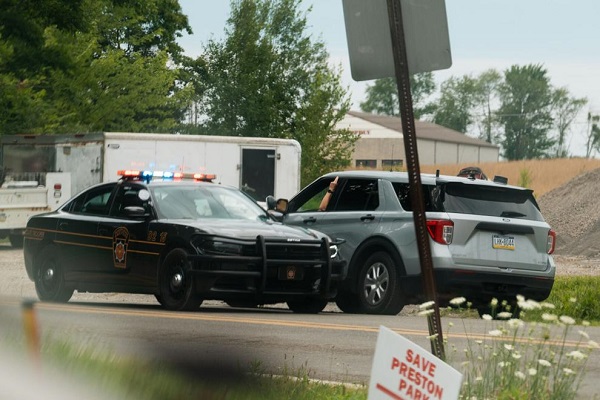International
Former Secret Service agents describe ‘apocalyptic security failure’ at Trump event

Police vehicles near the site of the Butler, Pa., venue where President Donald Trump was speaking when he was struck in the ear by a bullet in an assassination attempt
From The Center Square
Former U.S. Secret Service agents and security experts argue the Secret Service’s failure to prevent an assassination attempt against former President Donald Trump on Saturday was “apocalyptic,” exhibiting a “massive security breach.”
U.S. House Speaker Mike Johnson, R-Louisiana, has called for a congressional investigation. Multiple members of Congress are asking how a shooter ever reached a rooftop of a building to fire a shot at Trump, including U.S. Rep. Cory Mills, R-Florida, an Army veteran and counter sniper for the State Department who coordinated protective details for then Vice President Joe Biden, Condoleezza Rice and First Lady Laura Bush.
The assassination attempt on Trump was “a massive security breach,” Mills told CNN. The distance between the shooter and Trump was roughly 400 to 500 feet, “which is nothing for a shot adjacent to the stage of the president,” he said. “There was no one on that building, … in the building, standing next to the building to ensure there’s no access to the building,” he said. If there were, they “could have prevented this shooting.”
In an interview with Fox News, Mills said that the shots fired were the kind that soldiers learn in basic training boot camp and are “requested to make within nine weeks. This is one of the easiest shots.”
He said his job at the State Department involved working with an advanced team to establish a perimeter and “identify areas of threat that you would be able to mitigate … whether it be a building, … a lone tree … a parking lot. … Bottom line is this is massive negligence.”
Secret Service spokesperson Anthony Guglielmi has said agents responded quickly and the agency “added protective resources and technology and capabilities as part of [Trump’s] increased campaign travel.”
Former Secret Service agent Dan Bongino questioned this claim, asking on Fox News, “Which ones? You’re telling me the best technology you have was deployed and you missed a shooter 130 yards away … and even worse, it’s broad daylight on a white roof.”
He asked if there was forward-looking infrared deployed and if there was aerial support like drones and helicopters.
Bongino also pointed out that Trump “knew to duck … and saved his own life. That’s just a fact. The evacuation did not go right. The rule with the Secret Service is ‘cover the protectee’ and evacuate. The other rule is ‘maximum to the protectee, minimum to the problem. … Because you don’t know that’s the only problem. It could be a distraction. There could be another person in the crowd … you could be looking at multiple shooters.”
“The failure here is absolutely catastrophic,” he said, calling on Secret Service Director Kim Cheatle to resign immediately. He said Secret Service “absolutely resolutely 100% failed. This was an apocalyptic security failure. … An uneventful failure is never a success. The fact that Donald Trump didn’t die … is no reason for anybody to take some kind of victory lap.”
Former Secret Service agent Jeff James agreed, telling WTAE ABC News the agents on the stage should have moved Trump off sooner because the first shots fired “may have been the precursor in the real attack. There may have been four more gunmen who were going to start opening fire. I would have rather seen him get him into the armored cars and get him out of there more quickly.”
Bill Pickle, a former deputy assistant Secret Service director, told the Wall Street Journal, “The reality is there’s just no excuse for the Secret Service to be unable to provide sufficient resources to cover an open rooftop 100 yards away from the site. And there’s no way he should’ve got those shots off.”
Retired Secret Service agent Donald Mihalek called the failed assassination attempt “historic, drawing parallels to the 1912 shooting of Theodore Roosevelt in Milwaukee,” the Journal reported. “Roosevelt, then a former president who was running for a third term in the White House, was shot while heading to a campaign event. He survived the attempt on his life.”
Erik Prince, who previously provided diplomatic security services, said, “unaccountable bloated bureaucracies continue to fail us as Americans. Donald J. Trump is alive today solely due to a bad wind estimate by an evil would be assassin.”
Prince analyzed the wind at the time of the shot, arguing it was enough to displace the bullet two inches from Trump’s “intended forehead to his ear. DJT [Trump] was not saved by USSS [U.S. Secret Service] brilliance. The fact that USSS allowed a rifle armed shooter within 150 yards to a preplanned event is either malice or massive incompetence.
“Clearly there was adequate uncontrolled dead space for a shooter to move into position and take multiple aimed shots,” he said, adding that one counter sniper “was clearly overwhelmed as his face came off his rifle instead of doing his job to kill the shooter.”
A counter sniper killed the alleged shooter after he shot several rounds, wounding Trump, killing one, and critically wounding two others.
“In my old business of providing Diplomatic Security in two active war zones we were expected to execute the basics, or we would be fired,” Prince said. “Clearly USSS failed at the basics of a secure perimeter and once shots were fired, their extraction was clumsy and left DJT highly exposed to follow on attacks.”
He also expressed no confidence in anyone being held accountable, saying, “That’s not the Washington way. Unserious and unworthy people in positions of authority got us to this near disaster.”
Business
Warning Canada: China’s Economic Miracle Was Built on Mass Displacement

If you think the CCP will treat foreigners better than its own people, when it extends its power over you, please think again: Dimon Liu’s warning to Canadian Parliament.
Editor’s Note: The Bureau is publishing the following testimony to Canada’s House of Commons committee on International Human Rights from Dimon Liu, a China-born, Washington, D.C.-based democracy advocate who testified in Parliament on December 8, 2025, about the human cost of China’s economic rise. Submitted to The Bureau as an op-ed, Liu’s testimony argues that the Canadian government should tighten scrutiny of high-risk trade and investment, and ensure Canada’s foreign policy does not inadvertently reward coercion. Liu also warns that the Chinese Communist Party could gain leverage over Canadians and treat them as it has done to its own subjugated population—an implied message to Prime Minister Mark Carney, who has pledged to engage China as a strategic partner without making that position clear to Canadians during his election campaign.
OTTAWA — It is an honor to speak before you at the Canadian Parliament.
My testimony will attempt to explain why China’s economic success is built on the backs of the largest number of displaced persons in human history.
It is estimated that these displaced individuals range between 300 to 400 million — it is equivalent to the total population of the United States being uprooted and forced to relocate. These displaced persons are invisible to the world, their sufferings unnoticed, their plights ignored.
In 1978, when economic reform began, China’s GDP was $150 billion USD.
In 2000, when China joined the WTO, it was approximately $1.2 trillion USD.
China’s current GDP is approximately $18 trillion USD.
In 2000 China’s manufacturing output was smaller than Italy’s.
Today it’s larger than America, Europe, Japan, and South Korea combined.
If you have ever wondered how China managed to grow so fast in such a short time, Charles Li, former CEO of the Hong Kong Stock Exchange, has the answers for you.
He listed 4 reasons: 1) cheapest land, 2) cheapest labor, 3) cheapest capital, and 4) disregard of environmental costs.
“The cheapest land” because the CCP government took the land from the farmers at little to no compensation.
“The cheapest labor,” because these farmers, without land to farm, were forced to find work in urban areas at very low wages.
The communist household registration system (hukou 戶口) ties them perpetually to the rural areas. This means they are not legal residents, and cannot receive social benefits that legal urban residents are entitled. They could be evicted at any time.
One well known incident of eviction occurred in November 2017. Cai Qi, now the second most powerful man in China after Xi Jinping, was a municipal official in Beijing. He evicted tens of thousands into Beijing’s harsh winter, with only days, or just moments of notice. Cai Qi made famous a term, “low-end population” (低端人口), and exposed CCP’s contempt of rural migrants it treats as second class citizens.
These displaced migrant workers have one tradition they hold dear — it is to reunite with their families during the Chinese Lunar New Year holiday, making this seasonal migration of 100 to 150 million people a spectacular event. In China’s economic winter of 2025 with waves of bankruptcies and factory closures, the tide of unemployed migrant workers returning home to where there is also no work, and no land to farm, has become a worrisome event.
Historically in the last 2,000 years, social instability has caused the collapse of many ruling regimes in China.
“The cheapest capital” is acquired through predatory banking practices, and through the stock markets, first to rake in the savings of the Chinese people; and later international investments by listing opaque, and state owned enterprises in leading stock markets around the world.
“A disregard of environmental costs” is a hallmark of China’s industrialization. The land is poisoned, so is the water; and China produces one-third of all global greenhouse gases.
Chinese Communist officials often laud their system as superior. The essayist Qin Hui has written that the Chinese communist government enjoys a human rights abuse advantage. This is true. By abusing its own people so brutally, the CCP regime has created an image of success, which will prove to be a mirage.
If you think the CCP will treat foreigners better than its own people, when it extends its power over you, please think again.
The Bureau is a reader-supported publication.
To receive new posts and support my work, consider becoming a free or paid subscriber.
Artificial Intelligence
UK Police Pilot AI System to Track “Suspicious” Driver Journeys
AI-driven surveillance is shifting from spotting suspects to mapping ordinary life, turning everyday travel into a stream of behavioral data
|
|
-

 International2 days ago
International2 days agoAustralian PM booed at Bondi vigil as crowd screams “shame!”
-

 Uncategorized2 days ago
Uncategorized2 days agoMortgaging Canada’s energy future — the hidden costs of the Carney-Smith pipeline deal
-

 Alberta1 day ago
Alberta1 day agoAlberta Next Panel calls to reform how Canada works
-

 Automotive1 day ago
Automotive1 day agoCanada’s EV gamble is starting to backfire
-

 Digital ID17 hours ago
Digital ID17 hours agoCanadian government launches trial version of digital ID for certain licenses, permits
-

 Agriculture1 day ago
Agriculture1 day agoEnd Supply Management—For the Sake of Canadian Consumers
-

 Business16 hours ago
Business16 hours agoThe “Disruptor-in-Chief” places Canada in the crosshairs
-

 International16 hours ago
International16 hours agoWorld-leading biochemist debunks evolutionary theory






